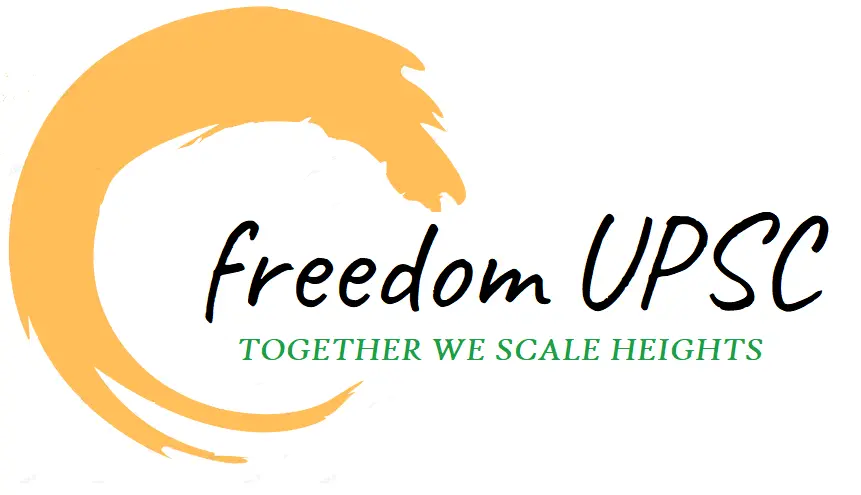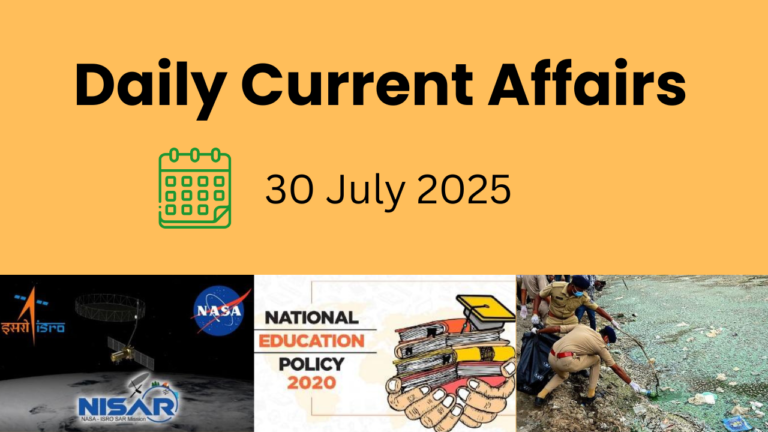1. Union Cabinet Approves Central Sector Scheme: Grant-in-Aid to NCDC
Context: To strengthen the cooperative sector and facilitate accessible credit to grassroots cooperatives, the Union Cabinet, chaired by Prime Minister Narendra Modi, has approved a new Central Sector Scheme (CSS) titled “Grant-in-Aid to National Cooperative Development Corporation (NCDC)”. This decision comes at a time when the government is pushing for greater participation of cooperatives in rural development, agriculture, and allied sectors. The aim is to provide financial assistance to cooperatives by enhancing the lending capacity of NCDC through a central grant mechanism.
Details:
Under the scheme, the Government of India will provide a total grant of ₹2,000 crore to NCDC, spread over a period of four years (from FY 2025–26 to FY 2028–29), with ₹500 crore allocated for each financial year. This grant will serve as a capital base to enable NCDC to leverage borrowings of up to ₹20,000 crore from the open market, which will be used to provide loans to cooperative societies across the country.
NCDC, which functions under the Ministry of Cooperation, will be the implementing agency responsible for disbursing the loans, monitoring project execution, and recovering funds. The scheme is expected to support approximately 13,288 cooperative societies, comprising nearly 2.9 crore individual members, particularly in sectors such as dairy, livestock, fisheries, agriculture, food processing, textiles, sugar cooperatives, labour cooperatives, and women-led cooperatives.
The loans will cover both capital expenditure (for infrastructure, technology upgrades, and new units) and working capital needs (for daily operations and production cycles). Loans may be extended directly to cooperative societies or routed through state governments, depending on NCDC’s funding norms and collateral or guarantee mechanisms.
One of the unique aspects of this scheme is the financial prudence of NCDC. The organization currently maintains a loan recovery rate of 99.8% with zero non-performing assets (NPAs), making it a reliable channel for the disbursal of public funds and market-raised capital. The high credibility and operational efficiency of NCDC allow for lower cost of borrowing and better outreach to underserved cooperative institutions.
Conclusion:
The newly approved Grant-in-Aid scheme marks a strategic move to deepen the reach of cooperative finance and to empower rural and grassroots institutions across sectors. By combining central support with market borrowings, the scheme ensures a multiplier effect on credit availability. The initiative reinforces the government’s commitment to reviving and modernizing the cooperative sector, positioning it as a strong pillar for inclusive economic growth and self-reliant rural development.
2. Union Minister Sarbananda Sonowal inaugurating 1MW green hydrogen plant
Context: On 31 July 2025, the Deendayal Port Authority (DPA), Kandla, commissioned India’s first “Make-in-India” 1 MW Green Hydrogen Plant, inaugurated by Union Minister of Ports, Shipping & Waterways, Sarbananda Sonowal. The facility is the first module of a larger planned 10 MW green hydrogen complex under the country’s clean energy transition push.
- The plant has been developed entirely by Indian engineers, with Make-in-India electrolyzers and components, and delivered by Larsen & Toubro (L&T)
- Completed within a rapid four-month timeframe, the plant sets a benchmark for scale and execution under the Maritime India Vision 2030
- At present, the plant can produce around 140 metric tonnes of green hydrogen annually, enough to power port facilities including 11 internal buses and street lighting, with future expansion planned for powering broader port operations
- This 1 MW module is Phase I of a larger 10 MW facility. A 5 MW module is expected to be operational by the end of FY 2025-26, with full 10 MW expected by mid-FY 2026-27
- The initiative underscores India’s commitment to maritime decarbonisation, making Kandla Port a leader in green operations. DPA has earlier deployed India’s first Make-in-India all-electric green tug, reinforcing its environmentally conscious credentials
- This green hydrogen facility is part of the government’s National Green Hydrogen Mission, aimed at achieving Net Zero emissions by 2030 and boosting energy self-reliance
- Sarbananda Sonowal described the plant as a “major step” towards India’s green vision and praised the execution for speed, scale, and skill. He reiterated the plant’s alignment with PM’s 2030 vision and its role in future green maritime infrastructure
- Minister of State, Shantanu Thakur, called the occasion a “proud moment for Gujarat and the country,” and said it elevated India’s status in clean energy leadership
- The inauguration was attended by key officials including the Ports Secretary T.K. Ramachandran, DPA Chairman Sushil Kumar Singh (IRSME), and senior representatives from L&T and DPA
Conclusion: The commissioning of the 1 MW Make-in-India green hydrogen plant at Kandla Port is a landmark achievement in India’s clean energy transition. Delivered entirely with indigenous technology in record time, it embodies sustainable innovation and sets a template for future port and industrial sustainability efforts. As Phase II unfolds and production scales up to 10 MW, the facility is poised to significantly strengthen India’s progress towards Net Zero targets, maritime decarbonisation, and technological self-reliance. This milestone not only elevates India’s global clean-energy credentials but also demonstrates how fast-track, skill-driven infrastructure can advance national priorities in climate resilience and green growth.
3. ICRISAT Launches AIPowered Climate Advisory Initiative for Farmers
Context: In line with India’s push toward climate-resilient agriculture, the International Crops Research Institute for the Semi-Arid Tropics (ICRISAT) launched a transformative project titled “AI-powered Context-Specific Agromet Advisory Services for Climate-Resilient Agriculture at Scale” during a two-day workshop on 29–30 July 2025 in Hyderabad. The initiative is part of the Union Government’s Monsoon Mission III and is designed to empower smallholder farmers with hyper-local, real-time climate and weather-based advisories. Ally partners include ICAR-CRIDA, ILRI, IITM, IMD, IIT Ropar, CSIO, and IISc.
Details
- This AI/ML-driven initiative aims to assist smallholder farmers dealing with unpredictable weather patterns by providing personalised, actionable insights based on crop stage, soil, location and socio-economic profile. The core consortium includes ICRISAT, ICAR-CRIDA, ILRI with technical inputs from IMD, IITM, and scientific institutions like IISc and CSIO.
- The flagship platform, known as iSAT (Intelligent Agricultural Systems Advisory Tool), integrates weather forecasts, satellite observations, crop and soil data using AI and rule-based engines. The advisories are disseminated via multiple channels including AI-powered WhatsApp bots, SMS, IVR, mobile apps and village resource centres in local languages.
- Piloted in Maharashtra through ICAR’s Agro-Meteorological Field Units, and earlier tested in Andhra Pradesh, Maharashtra, and Odisha through ISAT campaigns, the platform has reached over 6,000 farmers in Odisha alone. The personalized advisories support both pre-season planning and in-season management across all crop cycles.
Key Components & Features
- Seasonal and 5-day crop advisories related to sowing, irrigation, nutrient management, pest control, and harvesting.
- Delivered in local languages for maximum clarity.
- A feedback mechanism that continuously refines advisory accuracy and relevance.
- Designed for scalability and adaptability across regions, crops, and languages with modular architecture and partner-ready integration
Impacts & Farmer Experience: Field feedback shows enhanced decision-making confidence among farmers. In ISAT pilot villages, early sowing and input optimization led to yield improvements of up to 16% in groundnut cases. Around 80% of farmers expressed satisfaction with the timeliness and relevance of advisories, and 58% rated accuracy levels above 75%
Conclusion: The AI-powered climate advisory—anchored on the iSAT platform—marks a watershed moment in India’s digital agriculture evolution. By converging AI, meteorological science, and indigenous partner institutions, it extends personalised, climate-smart guidance to smallholder farmers in remote and semi-arid areas. Its ability to merge precision forecasting with local language delivery, plus an iterative feedback loop, positions it as a scalable model for enhancing resilience in agrarian communities.
This initiative exemplifies how technology-enabled agromet services can reduce weather-linked disruptions, support yield optimization, and strengthen rural livelihoods. As the initiative scales from pilot to broader rollout—and potentially into neighboring countries—it sets a template for climate-resilient, farmer-first digital transformation.
4. ITBPF and DBT signed mou for collaborative biomedical research and training in new Delhi
Context: On 31 July 2025, the Indo-Tibetan Border Police Force (ITBPF) and the Department of Biotechnology (DBT) under the Ministry of Science & Technology, Government of India, entered into a strategic Memorandum of Understanding (MoU) at the ITBP Headquarters in New Delhi. The signing ceremony was chaired by the Secretary, DBT (Dr. Rajesh S. Gokhale) and the Director General, ITBPF (Shri Rahul Rasgotra). The collaboration reflects India’s ambition for Viksit Bharat by 2047, emphasising science-based resilience for frontline paramilitary personnel.
Details
The MoU establishes a framework for translational biomedical research and capacity-building initiatives focused on health challenges encountered by ITBP personnel deployed in extreme high-altitude terrains like Ladakh, Arunachal Pradesh, and Uttarakhand.
Key focus areas include:
- Studying human adaptability to high altitude and hypoxia
- Innovation in frostbite mitigation, wound healing
- Development of probiotic nutrition solutions, biomedical devices, prosthetics
- Biosecurity management in remote border camps
Institutional Synergy
- ITBPF contributes field-level medical and paramedical infrastructure with real operational data from border posts.
- DBT, through its Biotechnology Research and Innovation Council (BRIC) network—including institutes like ICGEB, RCB, NIBG, THSTI, CIAB, and others—brings a formidable research and translational science ecosystem
The collaboration promises a blend of field insights and lab-based innovation, leading to deployable solutions.
The immediate pipeline includes:
- A physiological cohort study to create a risk stratification model assessing an individual’s adaptability to high-altitude conditions, helping refine deployment strategy and minimize medical emergencies.
- Research and development of topical agents for frostbite, biodegradable wound dressings, portable diagnostic kits, and specialized nutrition packs for cold-weather zones.
- Capacity-building modules, including training in Good Clinical Practices (GCP) and Health Economics & Outcomes Research (HEOR) for ITBP personnel and DBT scientists.
In the signing event, the Secretary, DBT described the MoU as a “guiding framework” for aligning biotechnology innovation to operational requirements, facilitating impactful, mission-oriented research. DG ITBP, Rahul Rasgotra, stated that the collaboration enhances “health, resilience and operational readiness” of personnel deployed in the toughest conditions and establishes scientific solutions tailored to mission needs.
Conclusion
The ITBPF–DBT MoU marks a strategic cross-sector partnership at the intersection of defence preparedness and biotech innovation. By converging frontline health needs with state-of-the-art R&D capabilities, this collaboration paves the way for developing context-specific biomedical solutions that align with India’s broader goals of self-reliance and innovation-led national security.
In a broader sense, this initiative reinforces the role of science and technology partnerships in strengthening India’s institutional capacity for protecting border forces. It also sets a precedent for deploying technology-enabled health frameworks in similarly extreme environments, reflecting a forward-looking approach to defence welfare and operational science.
5. Banking Law Amendment Act, 2025
Context: The Banking Laws (Amendment) Act, 2025, enacted via notification on 15 April 2025, embodies the government’s most comprehensive reform of the banking legal framework in decades. Its key provisions were officially brought into force by a Gazette notification (S.O. 3494(E)) dated 29 July 2025, and became effective from 1 August 2025.The Act introduces 19 amendments across five major statutes: the Reserve Bank of India Act, 1934; Banking Regulation Act, 1949; State Bank of India Act, 1955; and the Banking Companies (Acquisition and Transfer of Undertakings) Acts of 1970 & 1980.
Details:
- The Act raises the bar for what constitutes a director’s “substantial interest” in banking entities—from ₹5 lakh (unchanged since 1968) to ₹2 crore. This realignment ensures only significant shareholders can influence board appointments, strengthening conflict-of-interest norms and corporate governance.
- To align with the 97th Constitutional Amendment, the maximum tenure of directors (excluding chairperson and whole-time directors) in cooperative banks is extended from eight years to ten years. The move aims to enhance board continuity and institutional stability in cooperative institutions.
- Public Sector Banks (PSBs) are now empowered to transfer unclaimed dividends, unclaimed interest or redemption proceeds, and unclaimed shares to the Investor Education and Protection Fund (IEPF)—bringing them under the same regime as corporates under the Companies Act, 2013.
- The Act permits PSBs to fix remuneration for statutory auditors independently, instead of the RBI consulting with the government. This enhances auditor autonomy, helps attract high-quality audit professionals, and raises transparency and audit standards in PSBs
- Reporting timelines are revised—banks will now submit periodic reports to the RBI on the last day of the fortnight, month, or quarter, replacing the previous weekly Friday reporting norm. This eases administrative burden while maintaining reporting discipline
Conclusion
Conclusion
The Banking Laws (Amendment) Act, 2025 marks a strategic overhaul of India’s banking legislation. By increasing thresholds for director eligibility, extending cooperative bank tenures, aligning unclaimed assets with IEPF norms, empowering banks in auditor selection, and rationalising reporting schedules, the Act modernises governance and depositor safeguards.This shift reflects a deliberate move toward enhanced accountability, audit quality, depositor confidence, and institutional adaptability within banking. As India’s banking ecosystem continues to evolve amid economic growth and global integration, these legal reforms align regulatory practice with contemporary financial realities.
6. Myanmar Announces New Interim Union Government Led by U Nyo Saw
Context: On 31 July 2025, Myanmar’s National Defence and Security Council (NDSC) formally ended the four-year state of emergency, paving the way for planned national elections by December 2025. Concurrently, the Council disbanded the previous State Administration Council (SAC) and announced a new interim Union government, headed by U Nyo Saw as Prime Minister. Senior General Min Aung Hlaing will retain his dominance as Acting President and Chair of the newly formed State Security and Peace Commission, which will oversee elections and national security.
Details
The state of emergency decreed in February 2021 by then-Acting President U Myint Swe was lifted on 31 July 2025, just after its seventh six-month extension expired. As part of this transition, the order transferring sovereign powers to the Commander-in-Chief (Tatmadaw) was formally revoked by the NDSC.
New Government Structure & Leadership
- U Nyo Saw, a long-time adviser to Min Aung Hlaing and head of military-linked corporations like MEC, was named Prime Minister of the caretaker government. He also holds the role of Union Planning Minister.
- Senior General Min Aung Hlaing will maintain direct control over national affairs, serving as:
Acting President
Commander-in-Chief of Armed Forces
Chair of the rebranded State Security and Peace Commission (formerly SAC), consolidating legislative, executive, and security authority.
Half of the new Commission members are ex-SAC members, including top military brass, creating continuity in governance despite cosmetic structural changes.
Administrative Bodies & Institutions
- The State Security and Peace Commission, a newly constituted body under Min Aung Hlaing, will oversee national security and ensure “peaceful elections.”
- Bodies like the State Election Commission and the Anti-Corruption Commission have been restructured, albeit with limited autonomy and under military influence.
Elections, Martial Law & Civil Unrest
- Elections are tentatively scheduled for December 2025, though security concerns have prompted a phased voting plan through January 2026 in conflict zones.
- In 63 townships, including key resistance-controlled areas, martial law or emergency rules will remain in force to ensure “electoral order.”
- Armed clashes continue across the country, with ethnic armed groups and resistance forces controlling large parts of Myanmar. Opposition entities like the National Unity Government (NUG) and allied ethnic groups have rejected the polls as fraudulent and vowed continued resistance.
Conclusion:
Myanmar’s interim government formation under U Nyo Saw and the dissolution of the SAC represent significant institutional rebranding ahead of the December elections. Nonetheless, these changes are largely cosmetic, as Min Aung Hlaing retains consolidated authority over executive, military, and security functions. The announced transition appears aimed at presenting a façade of civilian rule and democratic normalization while maintaining comprehensive control. In the context of ongoing civil conflict and widespread resistance, the legitimacy of upcoming elections remains deeply questioned—both domestically and internationally.




